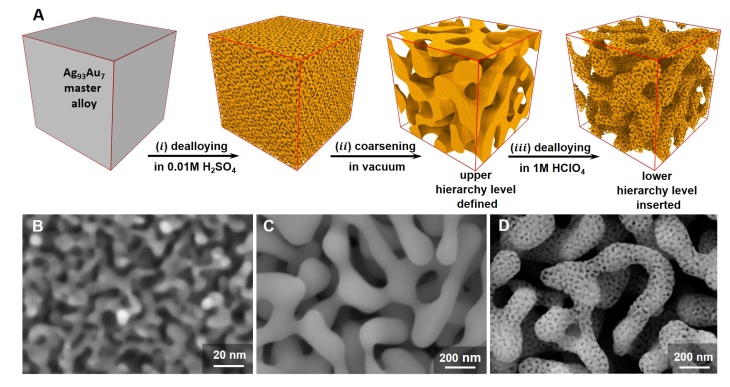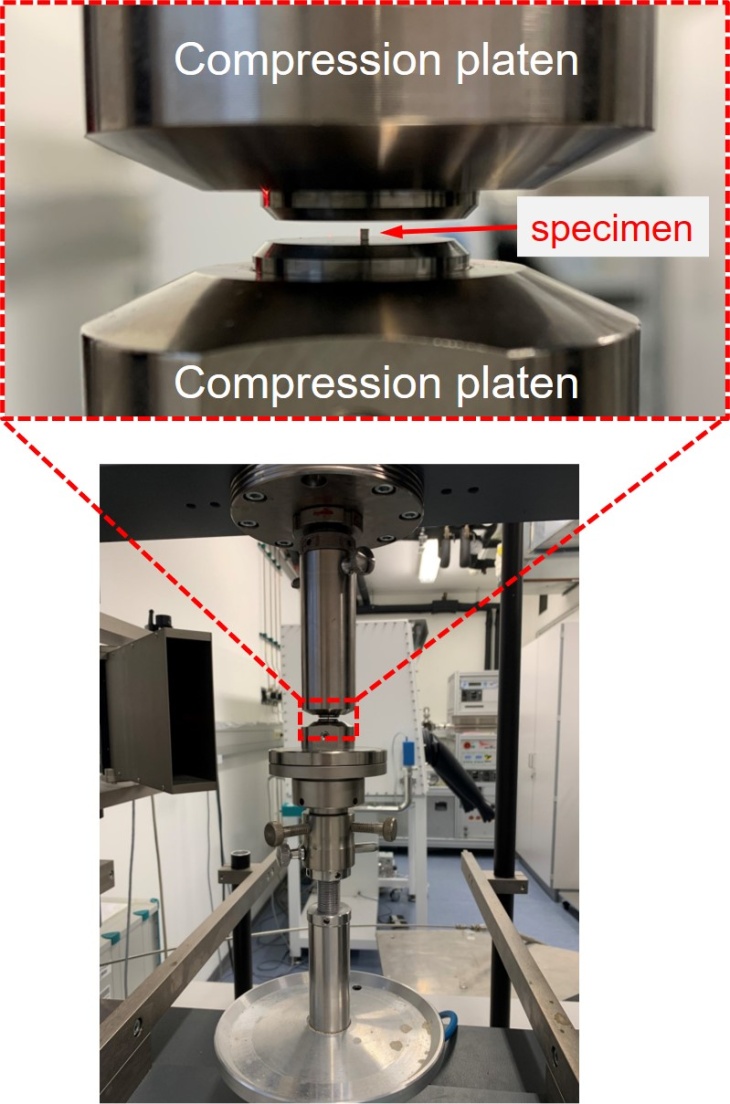High strength through hierarchy
Please note: Since the 31st of March 2021 the Helmholtz-Zentrum Geesthacht – Center for Materials and Coastal Research has a new name: Helmholtz-Zentrum Hereon. More information www.hereon.de/name
As light as possible and as strong as possible at the same time. These are the requirements for modern lightweight materials, such as those used in aircraft construction and the automotive industry. A research team from Helmholtz-Zentrum Geesthacht (HZG) and Hamburg University of Technology (TUHH) has now developed a new materials' design approach for future ultralight materials: Nanometer-sized metal struts that form nested networks on separate hierarchical levels provide amazing strength. The research group presents its findings in the current issue of the journal Science.

Scientists demonstrated for the first time that a hierarchical structure can be beneficial not only for macroscopic engineering truss structures such as the Eiffel Tower, but also for lightweight network materials. Photo: Jeremy Bishop via Unsplash
When the Eiffel Tower was inaugurated in 1889, it was considered a technical marvel. Its artful and delicate arrangement of large and small iron girders provided extraordinary stability and made sure it became the world’s tallest building at the time by a long shot. “Hierarchical” is what experts call the engineering approach of an open array of larger beams braced by smaller ones. For several years now, material science researchers have tried to transfer this efficient approach to the internal microstructure of materials, for example by using 3D printers that can replicate engineering truss structures on a micrometer scale.
So far, hopes of creating a new generation of extremely strong lightweight construction materials have not been fulfilled. One of the reasons: “A 3D printer can only print a maximum of roughly ten thousand beams and that will take hours,” according to Professor Jörg Weißmüller of the Institute of Materials Mechanics at HZG, co-author of the current publication. "For practical applications, this is not really a viable option."
Corroding away silver
Nevertheless, his team is pursuing an even more ambitious goal. The vision: If beams could be strengthened by downsizing to few nanometers in diameter, they could provide the basis for a new type of material – exceptionally light and at the same time strong. However, this kind of material would have to contain trillions of beams, far exceeding the capability of even the most sophisticated printer. “That is why we have to trick nature into making these kinds of materials for us, simply by self-organization,” Weißmüller’s colleague Dr. Shan Shi, lead author of the study, explains.

Experiment on the self-organization of the material: (A) Schematic illustration of the preparation route. The master alloy is first immersed in diluted sulphuric acid (i), which dissolves out about half the silver. The material is then heat-treated for coarsening (ii) and finally the remaining silver is washed out (iii). What remains is a hierarchically structured gold with two distinctly different strut sizes. Scanning electron microscope images showing the microstructures of (B) nanoporous Ag-Au, (C) coarsened nanoporous Ag-Au and (D) hierarchical nanoporous Au. Reprinted with permission from Shi et al Science, 5 March 2021 (DOI: 10.1126/science.abd9391)
As a start, the team used an alloy of 93% silver and 7% gold. This alloy is dipped into diluted sulfuric acid, dissolving out approximately half of the silver.

Dr. Shan Shi. Photo: HZG/Gesa Seidel
As a result, the remaining material rearranges itself, forming a delicate network of nanoscale beams. Afterwards, the material undergoes a heat treatment at several hundred degrees. “This coarsens the network to a beam size of 150 nanometers while maintaining the original architecture,” Shi explains.
During the last step, acid comes into play once again. It is used to wash out the rest of the silver, leaving only gold beams with a pore size of 15 nanometers on average. The result is a hierarchically structured material with two distinctly different beam sizes, not unlike the Eiffel Tower. As a result of its open network structure, this new material consists of 80 to 90% air, giving it a density of only 10 to 20% of the solid metal.
Amazingly light, amazingly strong

The scientists investigated the mechanical properties of the millimeter-sized samples with a load frame instrument. Reprinted with permission from Shi et al Science, 5 March 2021 (DOI: 10.1126/science.abd9391)
The research group then tested the mechanical properties of their millimeter-sized samples. “In view of this material’s low density, it shows exceptionally high values for key mechanical parameters such as strength and elastic modulus,” Jörg Weißmüller is happy to report. “We have removed much of the mass and left very little, but the material is much stronger than what has been state of the art until now.” This, he said, demonstrates for the first time that a hierarchical structure can be beneficial not only for macroscopic engineering truss structures such as the Eiffel Tower, but also for lightweight network materials.
The new material is not yet suitable for applications in lightweight construction – gold is simply too expensive, too heavy and too soft for that purpose. Yet, the new HZG materials design approach could conceivably be transferred to other, more technologically relevant metals like aluminum, magnesium or titanium. The researchers will then have tool face yet another challenge: So far, they have only been able to manufacture small, millimeter-sized samples. “But it seems entirely feasible to make wires or even whole sheets of metal by our process,” Weißmüller hopes. “At that point the material will become interesting in real life scenarios, for example, in new concepts for vehicles that are lighter and therefore more energy efficient.”
Original Publication
- Shan Shi, Yong Li, Bao-Nam Ngo-Dinh, Jürgen Markmann, Jörg Weissmüller Scaling Behavior of Stiffness and Strength of Hierarchical Network Nanomaterials, in Science 2021 (DOI: 10.1126/science.abd9391)
Further Information
- Hybrid Materials Systems Website of the department
Contact

Phone: +49 (0)4152 87-2648
E-mail contactInstitute of Materials Mechanics
Helmholtz-Zentrum Geesthacht

Phone: +49 (0)4152 87-2648
E-mail contactInstitute of Materials Mechanics
Helmholtz-Zentrum Geesthacht

Communication and Media
Helmholtz-Zentrum Geesthacht
